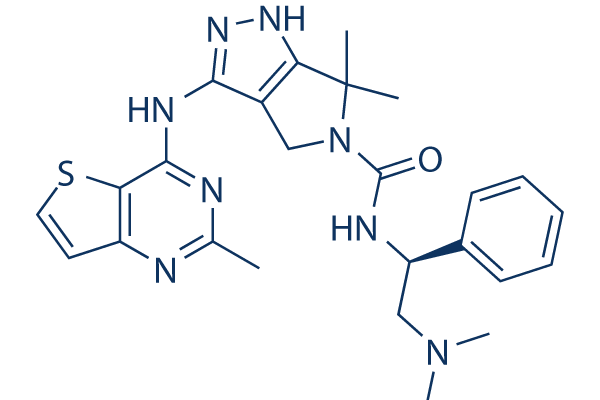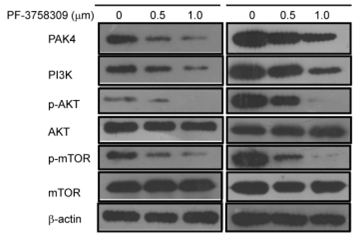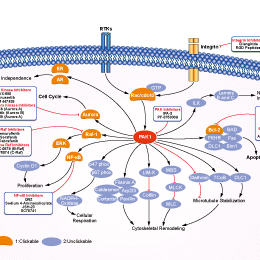
- Bioactive Compounds
- By Signaling Pathways
- PI3K/Akt/mTOR
- Epigenetics
- Methylation
- Immunology & Inflammation
- Protein Tyrosine Kinase
- Angiogenesis
- Apoptosis
- Autophagy
- ER stress & UPR
- JAK/STAT
- MAPK
- Cytoskeletal Signaling
- Cell Cycle
- TGF-beta/Smad
- DNA Damage/DNA Repair
- Compound Libraries
- Popular Compound Libraries
- Customize Library
- Clinical and FDA-approved Related
- Bioactive Compound Libraries
- Inhibitor Related
- Natural Product Related
- Metabolism Related
- Cell Death Related
- By Signaling Pathway
- By Disease
- Anti-infection and Antiviral Related
- Neuronal and Immunology Related
- Fragment and Covalent Related
- FDA-approved Drug Library
- FDA-approved & Passed Phase I Drug Library
- Preclinical/Clinical Compound Library
- Bioactive Compound Library-I
- Bioactive Compound Library-Ⅱ
- Kinase Inhibitor Library
- Express-Pick Library
- Natural Product Library
- Human Endogenous Metabolite Compound Library
- Alkaloid Compound LibraryNew
- Angiogenesis Related compound Library
- Anti-Aging Compound Library
- Anti-alzheimer Disease Compound Library
- Antibiotics compound Library
- Anti-cancer Compound Library
- Anti-cancer Compound Library-Ⅱ
- Anti-cancer Metabolism Compound Library
- Anti-Cardiovascular Disease Compound Library
- Anti-diabetic Compound Library
- Anti-infection Compound Library
- Antioxidant Compound Library
- Anti-parasitic Compound Library
- Antiviral Compound Library
- Apoptosis Compound Library
- Autophagy Compound Library
- Calcium Channel Blocker LibraryNew
- Cambridge Cancer Compound Library
- Carbohydrate Metabolism Compound LibraryNew
- Cell Cycle compound library
- CNS-Penetrant Compound Library
- Covalent Inhibitor Library
- Cytokine Inhibitor LibraryNew
- Cytoskeletal Signaling Pathway Compound Library
- DNA Damage/DNA Repair compound Library
- Drug-like Compound Library
- Endoplasmic Reticulum Stress Compound Library
- Epigenetics Compound Library
- Exosome Secretion Related Compound LibraryNew
- FDA-approved Anticancer Drug LibraryNew
- Ferroptosis Compound Library
- Flavonoid Compound Library
- Fragment Library
- Glutamine Metabolism Compound Library
- Glycolysis Compound Library
- GPCR Compound Library
- Gut Microbial Metabolite Library
- HIF-1 Signaling Pathway Compound Library
- Highly Selective Inhibitor Library
- Histone modification compound library
- HTS Library for Drug Discovery
- Human Hormone Related Compound LibraryNew
- Human Transcription Factor Compound LibraryNew
- Immunology/Inflammation Compound Library
- Inhibitor Library
- Ion Channel Ligand Library
- JAK/STAT compound library
- Lipid Metabolism Compound LibraryNew
- Macrocyclic Compound Library
- MAPK Inhibitor Library
- Medicine Food Homology Compound Library
- Metabolism Compound Library
- Methylation Compound Library
- Mouse Metabolite Compound LibraryNew
- Natural Organic Compound Library
- Neuronal Signaling Compound Library
- NF-κB Signaling Compound Library
- Nucleoside Analogue Library
- Obesity Compound Library
- Oxidative Stress Compound LibraryNew
- Plant Extract Library
- Phenotypic Screening Library
- PI3K/Akt Inhibitor Library
- Protease Inhibitor Library
- Protein-protein Interaction Inhibitor Library
- Pyroptosis Compound Library
- Small Molecule Immuno-Oncology Compound Library
- Mitochondria-Targeted Compound LibraryNew
- Stem Cell Differentiation Compound LibraryNew
- Stem Cell Signaling Compound Library
- Natural Phenol Compound LibraryNew
- Natural Terpenoid Compound LibraryNew
- TGF-beta/Smad compound library
- Traditional Chinese Medicine Library
- Tyrosine Kinase Inhibitor Library
- Ubiquitination Compound Library
-
Cherry Picking
You can personalize your library with chemicals from within Selleck's inventory. Build the right library for your research endeavors by choosing from compounds in all of our available libraries.
Please contact us at [email protected] to customize your library.
You could select:
- Antibodies
- Bioreagents
- qPCR
- 2x SYBR Green qPCR Master Mix
- 2x SYBR Green qPCR Master Mix(Low ROX)
- 2x SYBR Green qPCR Master Mix(High ROX)
- Protein Assay
- Protein A/G Magnetic Beads for IP
- Anti-Flag magnetic beads
- Anti-Flag Affinity Gel
- Anti-Myc magnetic beads
- Anti-HA magnetic beads
- Magnetic Separator
- Poly DYKDDDDK Tag Peptide lyophilized powder
- Protease Inhibitor Cocktail
- Protease Inhibitor Cocktail (EDTA-Free, 100X in DMSO)
- Phosphatase Inhibitor Cocktail (2 Tubes, 100X)
- Cell Biology
- Cell Counting Kit-8 (CCK-8)
- Animal Experiment
- Mouse Direct PCR Kit (For Genotyping)
- New Products
- Contact Us
PF-3758309
Synonyms: PF-03758309
PF-03758309 (PF-03758309) is a potent, ATP-competitive, pyrrolopyrazole inhibitor of PAK4 with Kd of 2.7 nM. PF-3758309 is antiproliferative and induces apoptosis in a HCT116 tumor model.

PF-3758309 Chemical Structure
CAS No. 898044-15-0
Purity & Quality Control
Batch:
Purity:
99.98%
99.98
PF-3758309 Related Products
| Related Targets | PAK1 PAK3 PAK2 PAK4 PAK5 PAK6 | Click to Expand |
|---|---|---|
| Related Products | IPA-3 FRAX597 FRAX486 FRAX1036 NVS-PAK1-1 LCH-7749944 | Click to Expand |
| Related Compound Libraries | Kinase Inhibitor Library Angiogenesis Related compound Library TGF-beta/Smad compound library Cytoskeletal Signaling Pathway Compound Library Anti-Cardiovascular Disease Compound Library | Click to Expand |
Signaling Pathway
Cell Data
| Cell Lines | Assay Type | Concentration | Incubation Time | Formulation | Activity Description | PMID |
|---|---|---|---|---|---|---|
| human MDA-MB-436 cells | Cytotoxic assay | 24-48 h | Cytotoxicity against human MDA-MB-436 cells assessed as reduction in cell viability after 24 to 48 hrs by Celltiter-glo luminescence assay, IC50=0.79 nM | 24432870 | ||
| HCT116 | Antiproliferative activity against | 72 hrs | Antiproliferative activity against human HCT116 cells after 72 hrs by CCK8 assay, IC50=0.039μM. | 29886323 | ||
| A549 | Antiproliferative activity against | 72 hrs | Antiproliferative activity against human A549 cells after 72 hrs by CCK8 assay, IC50=0.463μM. | 29886323 | ||
| TC32 | qHTS of pediatric cancer cell lines to identify multiple opportunities for | qHTS of pediatric cancer cell lines to identify multiple opportunities for drug repurposing: Primary screen for TC32 cells | 29435139 | |||
| DAOY | qHTS of pediatric cancer cell lines to identify multiple opportunities for | qHTS of pediatric cancer cell lines to identify multiple opportunities for drug repurposing: Primary screen for DAOY cells | 29435139 | |||
| SJ-GBM2 | qHTS of pediatric cancer cell lines to identify multiple opportunities for | qHTS of pediatric cancer cell lines to identify multiple opportunities for drug repurposing: Primary screen for SJ-GBM2 cells | 29435139 | |||
| A673 | qHTS of pediatric cancer cell lines to identify multiple opportunities for | qHTS of pediatric cancer cell lines to identify multiple opportunities for drug repurposing: Primary screen for A673 cells | 29435139 | |||
| SK-N-MC | qHTS of pediatric cancer cell lines to identify multiple opportunities for | qHTS of pediatric cancer cell lines to identify multiple opportunities for drug repurposing: Primary screen for SK-N-MC cells | 29435139 | |||
| BT-37 | qHTS of pediatric cancer cell lines to identify multiple opportunities for | qHTS of pediatric cancer cell lines to identify multiple opportunities for drug repurposing: Primary screen for BT-37 cells | 29435139 | |||
| NB-EBc1 | qHTS of pediatric cancer cell lines to identify multiple opportunities for | qHTS of pediatric cancer cell lines to identify multiple opportunities for drug repurposing: Primary screen for NB-EBc1 cells | 29435139 | |||
| U-2 OS | qHTS of pediatric cancer cell lines to identify multiple opportunities for | qHTS of pediatric cancer cell lines to identify multiple opportunities for drug repurposing: Primary screen for U-2 OS cells | 29435139 | |||
| Saos-2 | qHTS of pediatric cancer cell lines to identify multiple opportunities for | qHTS of pediatric cancer cell lines to identify multiple opportunities for drug repurposing: Primary screen for Saos-2 cells | 29435139 | |||
| SK-N-SH | qHTS of pediatric cancer cell lines to identify multiple opportunities for | qHTS of pediatric cancer cell lines to identify multiple opportunities for drug repurposing: Primary screen for SK-N-SH cells | 29435139 | |||
| NB1643 | qHTS of pediatric cancer cell lines to identify multiple opportunities for | qHTS of pediatric cancer cell lines to identify multiple opportunities for drug repurposing: Primary screen for NB1643 cells | 29435139 | |||
| LAN-5 | qHTS of pediatric cancer cell lines to identify multiple opportunities for | qHTS of pediatric cancer cell lines to identify multiple opportunities for drug repurposing: Primary screen for LAN-5 cells | 29435139 | |||
| BT-12 | qHTS of pediatric cancer cell lines to identify multiple opportunities for | qHTS of pediatric cancer cell lines to identify multiple opportunities for drug repurposing: Primary screen for BT-12 cells | 29435139 | |||
| Rh18 | qHTS of pediatric cancer cell lines to identify multiple opportunities for | qHTS of pediatric cancer cell lines to identify multiple opportunities for drug repurposing: Primary screen for Rh18 cells | 29435139 | |||
| OHS-50 | qHTS of pediatric cancer cell lines to identify multiple opportunities for | qHTS of pediatric cancer cell lines to identify multiple opportunities for drug repurposing: Primary screen for OHS-50 cells | 29435139 | |||
| RD | qHTS of pediatric cancer cell lines to identify multiple opportunities for | qHTS of pediatric cancer cell lines to identify multiple opportunities for drug repurposing: Primary screen for RD cells | 29435139 | |||
| MG 63 (6-TG R) | qHTS of pediatric cancer cell lines to identify multiple opportunities for | qHTS of pediatric cancer cell lines to identify multiple opportunities for drug repurposing: Primary screen for MG 63 (6-TG R) cells | 29435139 | |||
| fibroblast cells | qHTS of pediatric cancer cell lines to identify multiple opportunities for | qHTS of pediatric cancer cell lines to identify multiple opportunities for drug repurposing: Primary screen for control Hh wild type fibroblast cells | 29435139 | |||
| Rh41 | qHTS of pediatric cancer cell lines to identify multiple opportunities for | qHTS of pediatric cancer cell lines to identify multiple opportunities for drug repurposing: Primary screen for Rh41 cells | 29435139 | |||
| A673 | qHTS of pediatric cancer cell lines to identify multiple opportunities for | qHTS of pediatric cancer cell lines to identify multiple opportunities for drug repurposing: Confirmatory screen for A673 cells) | 29435139 | |||
| BT-12 | qHTS of pediatric cancer cell lines to identify multiple opportunities for | qHTS of pediatric cancer cell lines to identify multiple opportunities for drug repurposing: Confirmatory screen for BT-12 cells | 29435139 | |||
| Click to View More Cell Line Experimental Data | ||||||
Biological Activity
| Description | PF-03758309 (PF-03758309) is a potent, ATP-competitive, pyrrolopyrazole inhibitor of PAK4 with Kd of 2.7 nM. PF-3758309 is antiproliferative and induces apoptosis in a HCT116 tumor model. | |||||||||||
|---|---|---|---|---|---|---|---|---|---|---|---|---|
| Features | PF-3758309 is potent toward a broad array of tumor cell lines from different tumor types. | |||||||||||
| Targets |
|
| In vitro | ||||
| In vitro | PF-3758309 is a potent (Kd = 2.7 nM), ATP-competitive inhibitor of PAK4 with Ki of 18.7 nM. In cells, PF-3758309 inhibits phosphorylation of the PAK4 substrate GEF-H1 (IC50 = 1.3 nM) and anchorage-independent growth of a panel of tumor cell lines (IC50 = 4.7 nM). PF-3758309 also inhibits endogenous pGEF-H1 accumulation in HCT116 cells. PF-3758309 potently inhibits cellular proliferation (IC50 = 20 nM) and anchorage-independent growth (IC50 = 27 nM) of A549 cells. [1] |
|||
|---|---|---|---|---|
| Kinase Assay | Phospho-GEF-H1 Cellular Assay | |||
| TR-293-KDG cells are constructed from HEK293 cells stably transfected with tetracycline-inducible PAK4-kinase domain (amino acids 291-591) and constitutively expressed HA-tagged GEFH1ΔDH (amino acids 210-921). TR-293-KDG cells are incubated for 3 h with PF-3758309, captured on an anti-HA antibody-coated plate, detected with an anti-phospho-S810-GEF-H1 antibody, and quantified with a horseradish peroxidase-goat anti-rabbit antibody conjugate. | ||||
| Cell Research | Cell lines | HEK293T, HCT116, and SKOV3 cells | ||
| Concentrations | ~1 μM | |||
| Incubation Time | 72 hours | |||
| Method | A panel of cancer cell lines is used to test the potency of PF-3758309. On day 1, cells are plated on 384-well plates. Onday2, compounds are added to the cell culture. The cells are incubated with the compound for 3 days. On day 5, all media are aspirated from the wells. Dose-dependent effects of PF-3758309 on cell proliferation are quantified via the CellTiter-Glo Luminescent Cell Viability Assay(a,b,c), which is a homogeneous method of determining the number of viable cells in culture based on quantitation of the ATP present, an indicator of metabolically active cells. Proliferation data displayed for HEK293T, HCT116, and SKOV3 cells are measured using the Cyquant NF assay as specified by the manufacturer. Results for each drug are normalized to vehicle control and expressed as a percentage of maximum assay inhibition relative to Bleomycin. Error bars represent the SD from at least three experiments. |
|||
| Experimental Result Images | Methods | Biomarkers | Images | PMID |
| Western blot | PAK4 / PI3K / p-AKT / AKT / p-mTOR / mTOR |

|
28407679 | |
| In Vivo | ||
| In vivo | PF-3758309 blocks the growth of multiple human tumor xenografts, with a plasma EC50 value of 0.4 nM in the most sensitive model. PF-3758309 is antiproliferative and induces apoptosis in a HCT116 tumor model. [1] |
|
|---|---|---|
| Animal Research | Animal Models | Xenograft tumors in nude mice |
| Dosages | 7.5-30 mg/kg BID | |
| Administration | p.o. | |
Chemical Information & Solubility
| Molecular Weight | 490.62 | Formula | C25H30N8OS |
| CAS No. | 898044-15-0 | SDF | Download PF-3758309 SDF |
| Smiles | CC1=NC2=C(C(=N1)NC3=NNC4=C3CN(C4(C)C)C(=O)NC(CN(C)C)C5=CC=CC=C5)SC=C2 | ||
| Storage (From the date of receipt) | |||
|
In vitro |
DMSO : 98 mg/mL ( (199.74 mM) Moisture-absorbing DMSO reduces solubility. Please use fresh DMSO.) Ethanol : 98 mg/mL Water : Insoluble |
Molecular Weight Calculator |
|
In vivo Add solvents to the product individually and in order. |
In vivo Formulation Calculator |
||||
Preparing Stock Solutions
Molarity Calculator
In vivo Formulation Calculator (Clear solution)
Step 1: Enter information below (Recommended: An additional animal making an allowance for loss during the experiment)
mg/kg
g
μL
Step 2: Enter the in vivo formulation (This is only the calculator, not formulation. Please contact us first if there is no in vivo formulation at the solubility Section.)
% DMSO
%
% Tween 80
% ddH2O
%DMSO
%
Calculation results:
Working concentration: mg/ml;
Method for preparing DMSO master liquid: mg drug pre-dissolved in μL DMSO ( Master liquid concentration mg/mL, Please contact us first if the concentration exceeds the DMSO solubility of the batch of drug. )
Method for preparing in vivo formulation: Take μL DMSO master liquid, next addμL PEG300, mix and clarify, next addμL Tween 80, mix and clarify, next add μL ddH2O, mix and clarify.
Method for preparing in vivo formulation: Take μL DMSO master liquid, next add μL Corn oil, mix and clarify.
Note: 1. Please make sure the liquid is clear before adding the next solvent.
2. Be sure to add the solvent(s) in order. You must ensure that the solution obtained, in the previous addition, is a clear solution before proceeding to add the next solvent. Physical methods such
as vortex, ultrasound or hot water bath can be used to aid dissolving.
Tech Support
Answers to questions you may have can be found in the inhibitor handling instructions. Topics include how to prepare stock solutions, how to store inhibitors, and issues that need special attention for cell-based assays and animal experiments.
Tel: +1-832-582-8158 Ext:3
If you have any other enquiries, please leave a message.
* Indicates a Required Field
Frequently Asked Questions
Question 1:
If this compound crosses the blood brain barrier?
Answer:
We're sorry we don't have any data on whether S7094 can cross BBB or not, the following reference indicate that it can not: http://www.ncbi.nlm.nih.gov/pmc/articles/PMC3490962/.
Tags: buy PF-3758309 | PF-3758309 supplier | purchase PF-3758309 | PF-3758309 cost | PF-3758309 manufacturer | order PF-3758309 | PF-3758309 distributor







































